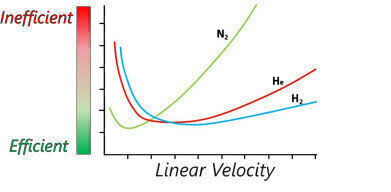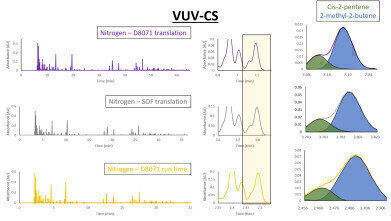-
 Figure 1. Efficiency vs. linear velocity (related to flow rate) for nitrogen, helium, and hydrogen. When picking a flow rate to optimize efficiency, hydrogen is the fastest carrier gas followed by helium and hydrogen, respectively.
Figure 1. Efficiency vs. linear velocity (related to flow rate) for nitrogen, helium, and hydrogen. When picking a flow rate to optimize efficiency, hydrogen is the fastest carrier gas followed by helium and hydrogen, respectively. -
 Figure 2. PIONA results for one gasoline sample run under each iteration of ASTM D8071 using helium, hydrogen, and nitrogen. Despite the notable differences in runtime brought about by different method conditions, the results are quite comparable for all methods.
Figure 2. PIONA results for one gasoline sample run under each iteration of ASTM D8071 using helium, hydrogen, and nitrogen. Despite the notable differences in runtime brought about by different method conditions, the results are quite comparable for all methods. -
 Figure 3. Chromatographic comparison of a gasoline sample analyzed under each of the nitrogen methods. As runtime decreases and lowers chromatographic resolution from top to bottom, peaks are compressed. However, GC-VUV is still able to distinguish and quantify coeluting compounds thanks to spectral deconvolution.
Figure 3. Chromatographic comparison of a gasoline sample analyzed under each of the nitrogen methods. As runtime decreases and lowers chromatographic resolution from top to bottom, peaks are compressed. However, GC-VUV is still able to distinguish and quantify coeluting compounds thanks to spectral deconvolution.
Analytical Instrumentation
Hydrogen and Nitrogen as Alternative Carrier Gases for the Analysis of Gasoline
Dec 11 2019
Helium has been the gold standard of gas chromatography (GC) carrier gases for many decades: it is inert, gives reasonable run times, and is safe to use. Unfortunately, helium shortages have increased prices, causing financial stress on labs that rely on it for GC analysis.
Helium isn’t the only option for gas chromatography; hydrogen and nitrogen are commonly cited as suitable alternatives. However, these three gases require different GC conditions to achieve optimal separation. Figure 1 shows the efficiency of each carrier gas as a function of linear velocity, which is related to flow rate. In general, hydrogen is most efficient at high flow rates, with nitrogen at slow rates and helium in between. When switching carrier gases, GC methods must be translated to maintain similar chromatography.
Additionally, many detectors are incompatible with some carrier gases – for example, mass spectrometers lose sensitivity when using nitrogen due to its increased ion scattering and ability to ionise more easily than helium.
The VUV Analyzer™ Platform offers greater adaptability to different carrier gases than other analysers. The VUV Analyzer Platform is fully compatible with all three carrier gases, and its ability to spectrally deconvolve coelutions allows for greater flexibility in method development. To demonstrate this utility, several gasoline-range samples were analysed using nitrogen, hydrogen, and helium. Various iterations of ASTM D8071 conditions were used, including translated methods, speed-optimised flow (SOF) translations to decrease runtime with a minimal loss of resolution, and methods with run times matching ASTM D8071 (33.6 minutes) for each carrier gas. The data for one gasoline sample is shown in Figure 2.
As expected, the translations of ASTM D8071 to hydrogen and nitrogen decreased and increased the runtimes respectively, and the SOF translations sped up each method significantly. Normally, adjusting a method to shorten its runtime carries the risk of poor data quality due to loss in resolution; however, the VUV Analyzer’s results have proven to be quite impressive. Despite the differences in method conditions and resolution, the PIONA results for each iteration of ASTM D8071 are very comparable; for example, even when the nitrogen translation was shortened by over 50% to 33.6 minutes, the data obtained still compared very well to each of the other methods.
The VUV Analyzer Platform owes its flexibility for alternate carrier gas method development to spectral deconvolution, which can tackle coelutions brought about by changes in method conditions. Figure 3 demonstrates spectral deconvolution at work for a series of gasoline runs under nitrogen – the runs shown have sequentially shorter run times, meaning that chromatographic resolution is lost with each run. However, the VUV Analyzer can easily identify and quantify these compounds for PIONA analysis.
Both nitrogen and hydrogen give great approximations of data gathered using helium, making them viable alternatives for fuels analysis. As helium prices continue to increase, the VUV Analyzer Platform for Fuels is THE option that can make the carrier gas transition a little smoother.
Digital Edition
PIN 25.1 Feb/March
March 2024
In This Edition Safety - The technology behind the ION Science Tiger XT - Safety with ammonia and LOHCs as hydrogen carriers Analytical Instrumentation - Discussion on new tribology te...
View all digital editions
Events
Apr 30 2024 Birmingham, UK
May 03 2024 Seoul, South Korea
May 05 2024 Seville, Spain
May 06 2024 Riyadh, Saudi Arabia
May 06 2024 Houston, Tx, USA

















